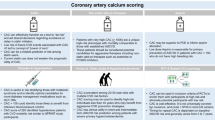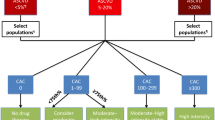Abstract
Purpose of Review
Review the role of coronary artery calcium (CAC) testing in designing future clinical trials in primary prevention.
Recent Findings
While there are numerous new agents that have been found to lower cardiovascular event rates in clinical trials, these studies have required a large sample size, in part due to low event rates as well as improved baseline treatments. More precise risk assessment could allow for better identification of individuals who stand to derive the most benefit from various therapies. Coronary CAC testing offers a simple method for identifying high-risk primary prevention cohorts, and thus may allow for improved efficiency of clinical trials, enhanced efficacy of various therapies, and ultimately more favorable cost-effectiveness estimates.
Summary
The use of CAC testing as part of the inclusion criteria used in clinical trials may result in identifying high-risk individuals who were previously not included in such studies while achieving favorable absolute risk reductions. The advantages afforded by using CAC to enrich clinical trials offer a potential road map for future clinical trials in primary prevention.


Similar content being viewed by others
References
Papers of particular interest, published recently, have been highlighted as: • Of importance •• Of major importance
ViraniSalim S, Alvaro Alonso, Benjamin Emelia J, et al. Heart Disease and Stroke Statistics—2020 Update: a report from the American Heart Association. Circulation. 2020;141:e139–596.
Heidenreich PA, Trogdon JG, Khavjou OA, et al. Forecasting the future of cardiovascular disease in the United States: a policy statement from the American Heart Association. Circulation. 2011;123:933–44.
Dunbar SB, Khavjou OA, Bakas T, et al. Projected costs of informal caregiving for cardiovascular disease: 2015 to 2035: a policy statement from the American Heart Association. Circulation. 2018;137:e558–77.
Ridker PM, Wilson PWF. A trial-based approach to statin guidelines. JAMA. 2013;310:1123.
Ridker PM, Rose L, Cook NR. A proposal to incorporate trial data into a hybrid ACC/AHA algorithm for the allocation of statin therapy in primary prevention. J Am Coll Cardiol. 2015;65:942–8.
Bødtker Mortensen Martin, Erling Falk, Dong Li, et al. Statin trials, cardiovascular events, and coronary artery calcification. JACC Cardiovasc Imaging. 2018;11:221–30.
•• Greenland P, Michos ED, Redmond N, et al. Primary prevention trial designs using coronary imaging: a national heart, lung, and blood institute workshop. JACC Cardiovasc. Imaging. 2020. Available at: https://imaging.onlinejacc.org/content/early/2020/09/09/j.jcmg.2020.06.042. Accessed 8 Oct 2020. This study highlights the findings from the 2019 NHLBI multi-disciplinary working group reviewing the evidence and the appropriateness of further research on CAC testing and other cardiac imaging modalities for primary preventive therapies in CVD disease.
Rozanski A, Muhlestein JB, Berman DS. Primary prevention of CVD: the role of imaging trials. JACC Cardiovasc Imaging. 2017;10:304–17.
Lloyd-Jones DM, Braun LT, Ndumele CE, et al. Use of risk assessment tools to guide decision-making in the primary prevention of atherosclerotic cardiovascular disease. J Am Coll Cardiol. 2019;73:3153–67.
Budoff MJ, Shaw LJ, Liu ST, et al. Long-term prognosis associated with coronary calcification: observations from a registry of 25,253 patients. J Am Coll Cardiol. 2007;49:1860–70.
Detrano R, Guerci AD, Carr JJ, et al. Coronary calcium as a predictor of coronary events in four racial or ethnic groups. N Engl J Med. 2008;358:1336–45.
Polonsky TS. Coronary artery calcium score and risk classification for coronary heart disease prediction. JAMA. 2010;303:1610.
Tota-Maharaj R, Blaha MJ, McEvoy JW, et al. Coronary artery calcium for the prediction of mortality in young adults <45 years old and elderly adults >75 years old. Eur Heart J. 2012;33:2955–62.
Sarwar A, Shaw LJ, Shapiro MD, et al. Diagnostic and prognostic value of absence of coronary artery calcification. JACC Cardiovasc Imaging. 2009;2:675–88.
Khurram Nasir, Bittencourt Marcio S, Blaha Michael J, et al. Implications of coronary artery calcium testing among statin candidates according to American College of Cardiology/American Heart Association cholesterol management guidelines. J Am Coll Cardiol. 2015;66:1657–68.
Khurram N. Message for 2018 Cholesterol management guidelines update. J Am Coll Cardiol. 2018;72:3243–5.
Dzaye O, Dardari ZA, Cainzos-Achirica M, et al. Warranty period of a calcium score of zero: comprehensive analysis from the multiethnic study of atherosclerosis. JACC Cardiovasc Imaging. 2020.
Blaha Michael J, Ron Blankstein, Khurram Nasir. Coronary artery calcium scores of zero and establishing the concept of negative risk factors∗. J Am Coll Cardiol. 2019;74:12–4.
Yano Y, O’Donnell CJ, Kuller L, et al. Association of coronary artery calcium score vs age with cardiovascular risk in older adults: an analysis of pooled population-based studies. JAMA Cardiol. 2017;2:986–94.
Carr JJ, Jacobs DR, Terry JG, et al. Association of coronary artery calcium in adults aged 32 to 46 years with incident coronary heart disease and death. JAMA Cardiol. 2017;2:391–9.
Miedema MD, Dardari ZA, Nasir K, et al. Association of coronary artery calcium with long-term, cause-specific mortality among young adults. JAMA Netw Open. 2019;2:e197440.
Hecht HS, de Siqueira MEM, Cham M, et al. Low- vs. standard-dose coronary artery calcium scanning. Eur Heart J Cardiovasc Imaging. 2015;16:358–63.
• Cainzos-Achirica M, Bittencourt MS, Osei AD, et al. Coronary artery calcium to improve the efficiency of randomized controlled trials in primary cardiovascular prevention. JACC Cardiovasc Imaging. 2021;14:1005–16. Findings from this study suggest the use of CAC testing in a future randomized primary prevention trial can lower the sample size, and reduce projected costs by identifying participants with the highest risk for future cardiovascular events.
Cainzos-Achirica M. Coronary artery calcium to improve the efficiency of randomized controlled trials in primary cardiovascular prevention. Cardiovasc Imaging. 2020:12.
Faulkner E, Annemans L, Garrison L, et al. Challenges in the development and reimbursement of personalized medicine—payer and manufacturer perspectives and implications for health economics and outcomes research: a report of the ISPOR Personalized Medicine Special Interest Group. Value Health. 2012;15:1162–71.
Arad Y, Spadaro LA, Roth M, Newstein D, Guerci AD. Treatment of asymptomatic adults with elevated coronary calcium scores with atorvastatin, vitamin C, and vitamin E: the St. Francis Heart Study Randomized Clinical Trial. J Am Coll Cardiol. 2005;46:166–72.
O’Malley PG, Feuerstein IM, Taylor AJ. Impact of electron beam tomography, with or without case management, on motivation, behavioral change, and cardiovascular risk profile: a randomized controlled trial. JAMA. 2003;289:2215–23.
Rozanski A, Gransar H, Shaw LJ, et al. Impact of coronary artery calcium scanning on coronary risk factors and downstream testing: the EISNER (Early Identification of Subclinical Atherosclerosis by Noninvasive Imaging Research) Prospective Randomized Trial. J Am Coll Cardiol. 2011;57:1622–32.
Denissen SJ, van der Aalst CM, Vonder M, Oudkerk M, de Koning HJ. Impact of a cardiovascular disease risk screening result on preventive behaviour in asymptomatic participants of the ROBINSCA trial. Eur J Prev Cardiol. 2019;26:1313–22.
Nidorf SM, Fiolet ATL, Mosterd A, et al. Colchicine in patients with chronic coronary disease. N Engl J Med. 2020;383:1838–47.
Marwick TH, Whitmore K, Nicholls SJ, et al. Rationale and design of a trial to personalize risk assessment in familial coronary artery disease. Am Heart J. 2018;199:22–30.
Amgen. A double-blind, randomized, placebo-controlled, multicenter study to evaluate the impact of evolocumab on major cardiovascular events in patients at high cardiovascular risk without prior myocardial infarction or stroke.clinicaltrials.gov; 2020. Available at: https://clinicaltrials.gov/ct2/show/NCT03872401. Accessed 3 Dec 2020.
Intermountain Health Care, Inc. Effectiveness of a proactive cardiovascular primary prevention strategy, with or without the use of coronary calcium screening, in preventing future major adverse cardiac events. clinicaltrials.gov; 2019. Available at: https://clinicaltrials.gov/ct2/show/NCT03439267. Accessed 3 Dec 2020.
Singh A, Collins BL, Gupta A, et al. Cardiovascular risk and statin eligibility of young adults after an MI: partners YOUNG-MI Registry. J Am Coll Cardiol. 2018;71:292–302.
Sameer Arora, Stouffer George A, Kucharska-Newton Anna M, et al. Twenty year trends and sex differences in young adults hospitalized with acute myocardial infarction. Circulation. 2019;139:1047–56.
Miedema MD, Nauffal VD, Singh A, Blankstein R. Statin therapy for young adults: a long-term investment worth considering. Trends Cardiovasc Med. 2020;30:48–53.
Author information
Authors and Affiliations
Corresponding author
Ethics declarations
Human and Animal Rights and Informed Consent
This article does not contain any studies with human or animal subjects performed by any of the authors.
Conflict of Interest
Dr. Khurram Nasir is on the Advisory Boards of Amgen, Novartis, and Novo Nordisk. His research is partly supported by the Jerold B. Katz Academy of Translational Research.
Dr. Blankstein has received research support from Amgen Inc. and Novartis Inc; and is on the Advisory boards of Caristo and Roivant Sciences Inc, outside the submitted work.
The other authors report no conflicts of interest.
Additional information
Publisher's Note
Springer Nature remains neutral with regard to jurisdictional claims in published maps and institutional affiliations.
This article is part of the Topical Collection on Evidence-Based Medicine, Clinical Trials and Their Interpretations
Rights and permissions
About this article
Cite this article
Fentanes, E., Cainzos Achirica, M., Nasir, K. et al. The Role of Coronary Artery Calcium Testing for Value-Based Clinical Trials in Primary Prevention. Curr Atheroscler Rep 23, 73 (2021). https://doi.org/10.1007/s11883-021-00969-6
Accepted:
Published:
DOI: https://doi.org/10.1007/s11883-021-00969-6




